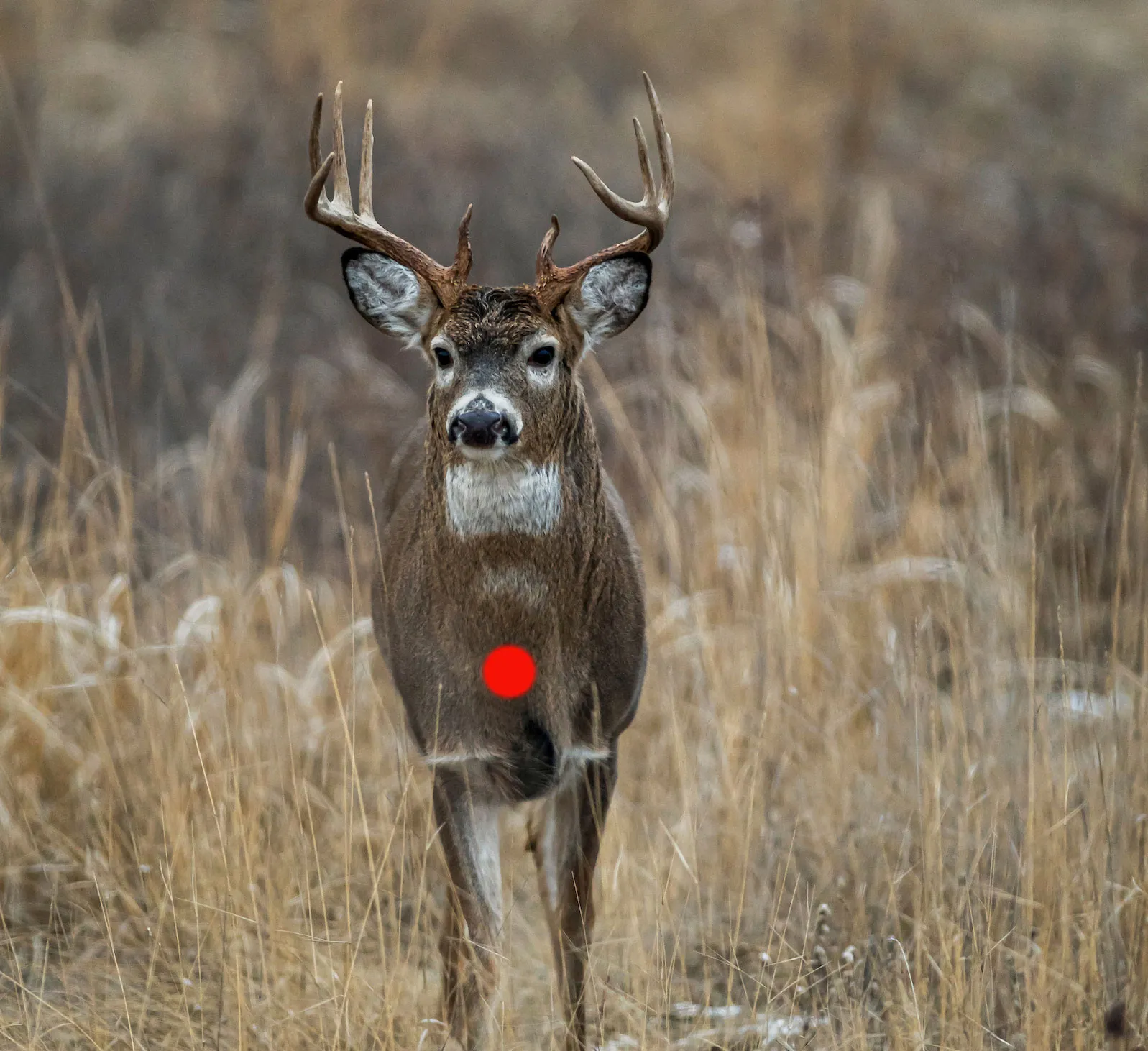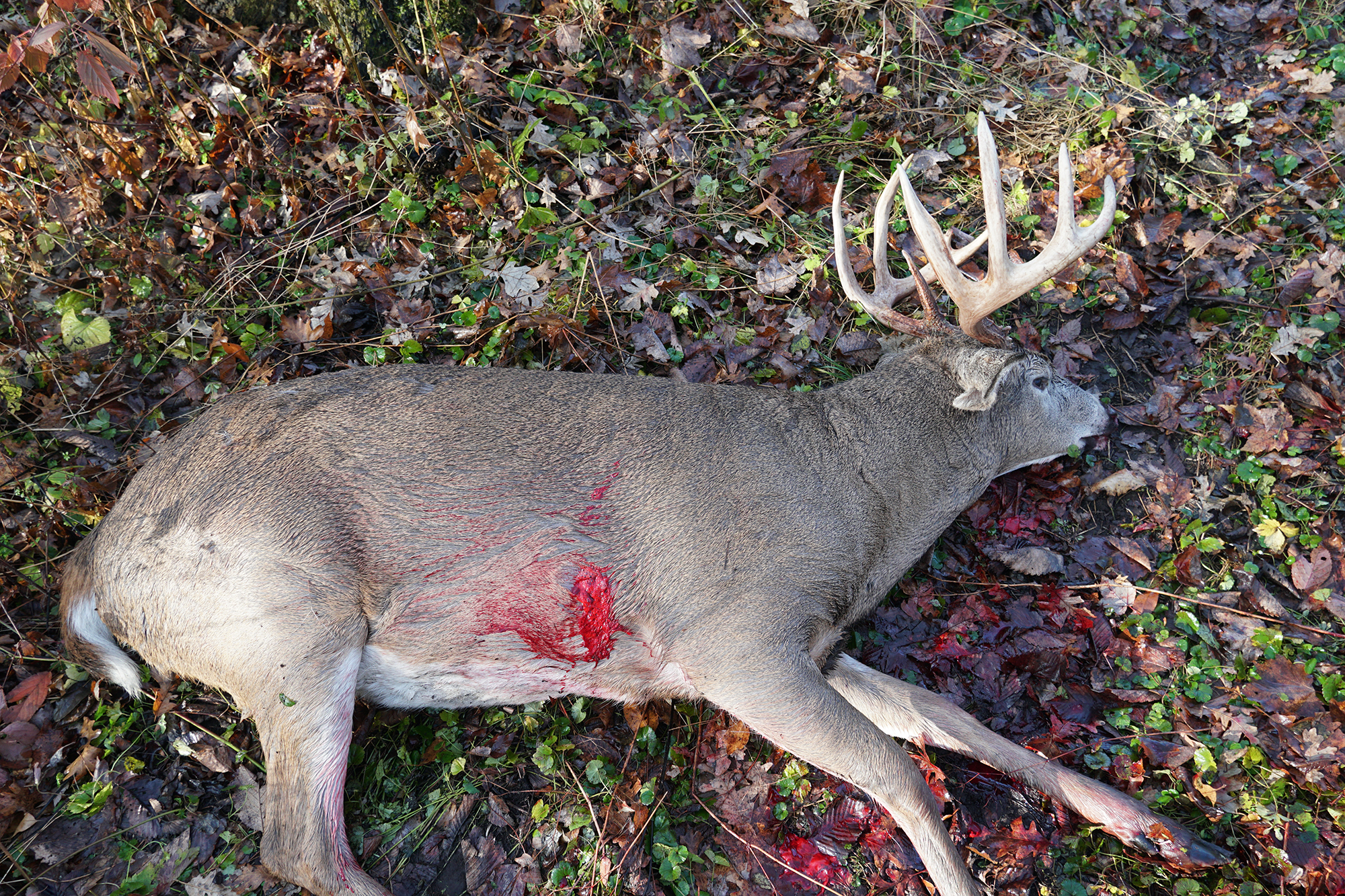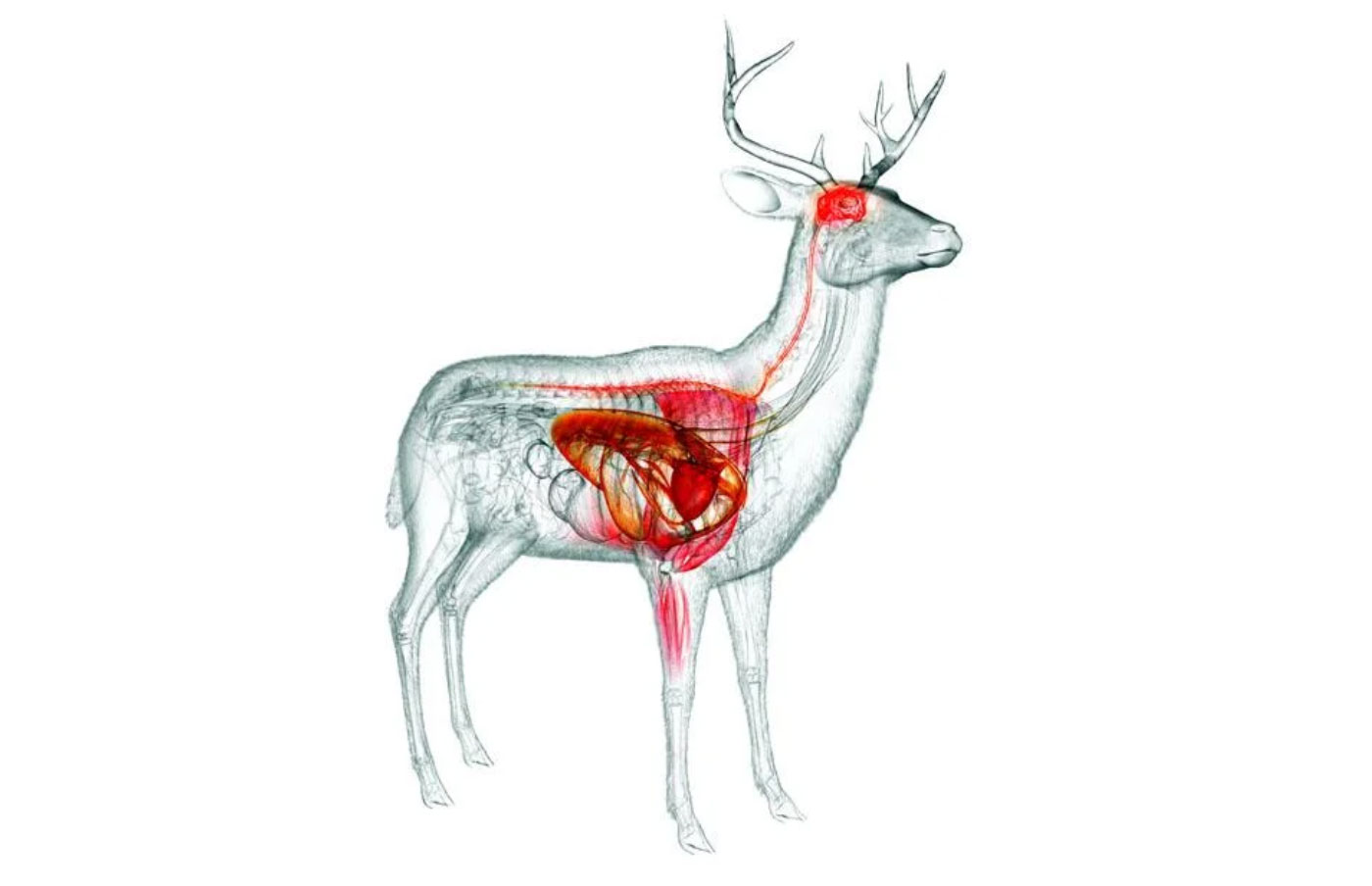
Understanding the place to shoot a deer for a fast kill is the duty of each deer hunter. Most of us had been taught that the very best place to shoot a deer is the “boiler room,” which implies the highest of the guts and the lungs. For the overwhelming majority of searching situations, that’s nonetheless the best choice. Penetrating these important organs (with a bullet or an arrow) results in large blood loss and a fast demise. It additionally ends in very minimal meat injury.
So, if you wish to shoot a deer within the coronary heart and lungs, the place precisely must you intention?
Put merely, if the deer is broadside, comply with the entrance leg up the deer and intention slightly below the midway level on its chest. Search for the “crease” that the deer’s shoulder creates. Capturing with a rifle, you may edge tighter to the deer’s shoulder. Bowhunters wish to hit simply an inch or two behind the crease, which permits somewhat extra room for error (extra on this later).
There isn’t a lot of a distinction in intention level for rifle hunters or bowhunters, as you may see within the photograph under.
The video under, created by the Nationwide Deer Affiliation, does a superb job explaining the place to shoot a deer on an anatomically appropriate deer goal. Look carefully on the bone construction of a deer’s shoulder. It isn’t one stable mass of bone. First the bone angles ahead of the leg after which the shoulder blade sweeps again. Understanding this anatomy is particularly essential for archers who usually wish to keep away from hitting these giant bones with their arrow (well constructed rifle bullets will simply blast by way of bones). It is a key distinction for bowhunters: There’s merely a a lot smaller margin of error.

Understanding Shot Angles
Now, the dialogue on the place to shoot a deer will get extra sophisticated when deer are quartering away from you or angling towards you. You continue to wish to hit the important space of the guts and lungs, however now you should change your intention level. One of the best ways to do that is to visualise the place the guts and lungs are positioned inside the deer’s physique cavity and intention in order that your bullet or arrow angles by way of them. Basically, this implies holding farther again on quartering away photographs and farther ahead on quartering-to photographs.
Quartering-Away Pictures

Many hunters want quartering-away photographs to broadside photographs. In some circumstances, the angle creates a bigger margin of error for hitting the lungs. Plus, the deer is dealing with away from you so it’s simpler to attract or shoulder your gun with out being detected.
Visualize an angle that takes your bullet or arrow by way of the deer’s coronary heart and lungs after which continues into its offside shoulder, or simply in entrance of it. A technique to do that is to take a look at the offside leg. Observe the entrance of the offside leg as much as the physique.
The photograph above is the intention level for bowhunters on this angle. Rifle hunters ought to intention a couple of inches farther ahead.
Quartering-To Pictures

Quartering-to photographs will not be excellent for bowhunters. It is because you should maintain into the shoulder or danger hitting guts. Lighter arrows and decrease draw weight bows won’t penetrate bones within the deer’s shoulder. However for rifle hunters capturing high quality bullets, the quartering-to angle nonetheless presents an excellent shot alternative. You will need to maintain into the frontside shoulder now, together with your bullet exiting the center or again of the rib cage. This shot will injury extra meat than a well-executed broadside shot.
Frontal Pictures

Frontal photographs could be extremely efficient however they provide a smaller margin of error than broadside photographs. When a deer is dealing with instantly towards you, intention between the 2 shoulders, slightly below the half-way level on its chest. Executed correctly, this shot sometimes drops deer in a short time. As a result of your goal is far narrower at this angle, nonetheless, this shot ought to solely be taken at shut ranges.
Bowhunters who hunt from the bottom and rattle in or decoy bucks generally see frontal photographs. When you’re a bowhunter and intend to take frontal photographs, it is best to go for a heavy arrow with a high FOC and heavy, sturdy fixed-blade broadheads. However most significantly, you should have your setup tuned properly and be capable of shoot baseball sized teams with out fail.
The place to Shoot a Deer with a Bow
Capturing a deer with a bow is extra sophisticated than capturing one with a gun. As we’ve already mentioned, there’s much less margin for error with archery gear. Plus, since bowhunters are sometimes searching from treestands and taking close-range photographs, they must account for the sharper angle of the shot. Lastly, deer generally jump a bow string on farther photographs, that means they duck or spin the moment you unfastened your arrow. Right here’s what it is advisable find out about the place to shoot a deer with a bow.
Crease vs the Very important V

Many bowhunters advocate for capturing deer by way of the shoulder within the “important V,” as a substitute of the crease. By this they imply, holding into the deer’s shoulder, the place its humerus and scapula make a sideways V form. When you place your arrow by way of this window, it’s unarguably lethal. There aren’t any bones (moreover the ribcage) on this V. Plus, bowhunters capturing heavy arrows, stout draw weights, and sturdy fixed-blade broadheads are in a position to penetrate these bones with out challenge anyway. The YouTube persona “Ranch Fairy” has been one of the distinguished fashionable advocates of aiming for the Very important V, and you may see his clarification within the video under.

Aiming for the important V is problematic, nonetheless, particularly for brand new bowhunters. When you pull your shot low or ahead, you’ll hit heavy bones within the shoulder, which your arrow won’t go by way of. Plus, the lungs slender within the deer’s ahead physique cavity. Most bowhunter’s training programs, and this writer advocate holding farther again into the crease of the deer’s shoulder, and not aiming for the important V.

So long as you’re utilizing high quality archery gear, a well-placed shot by way of the crease will probably be lethal, nearly with out fail. Arrow weight, broadhead style, and draw weight aren’t as a lot of an element right here. Plus, you have got barely extra room for error by holding behind the shoulder. By aiming for the crease, you’re holding for the realm on the deer’s physique the place the lungs are the tallest and widest. When you miss somewhat ahead, you’ll seemingly hit the important V, if you happen to miss somewhat again, you’ll seemingly hit the again of the lungs and liver.
It’s additionally straightforward to see the crease and use it as a selected spot to intention for. Selecting a singular intention level is essential.
Learn Subsequent: Why Mechanical Broadheads Are Still the Best Option for Most Deer Hunters
Capturing from a Tree Stand
When capturing from a tree stand, your arrow will probably be putting deer at a downward angle. The upper your stand and the nearer the deer, the steeper this angle will probably be. For instance, if you happen to’re 20 ft up, capturing a deer that’s 15 yards away, you’ll be capturing downward at an roughly 60-degree angle. When your arrow strikes the deer, it’s going to look one thing just like the photograph under.
So for shut photographs at a steep angle, you wish to intention barely larger. This ensures your arrow will go by way of each lungs. However the key phrase right here is “barely.” Usually talking, hitting a deer too excessive with a bow is unhealthy.
One of the best factor you are able to do to grasp elevated shot angles to is follow them. Use a 3D goal and shoot from an elevated place, as if you happen to had been in a treestand. This can enable you get an instinctual understanding of the place to carry for various shot angles. You need your arrow to go by way of the highest of the close to lung and the underside of the far lung.
Leaping the String
All of this will get a bit harder for bowhunters as a result of so typically deer jump the string or duck on the sound of the bow releasing. That is sometimes solely a difficulty past 20 yards. Some bowhunters resolve for this by merely aiming somewhat decrease for farther photographs. For photographs past 20 yards, it’s a good suggestion to carry somewhat decrease, however nonetheless within the important zone. Nevertheless there isn’t any rule or components for outsmarting string-jumping deer.
“Their reactions are so dynamic and completely different in each scenario that you just can’t predict what the deer goes to do,” says Aaron Warbritton of The Hunting Public. “Over all of the video we’ve watched, we seen that some deer would duck straight all the way down to the bottom. Some deer would drop a foot at 30 yards. Some would drop 4 inches at 30 yards. Some wouldn’t transfer at 30 yards. Some would duck and roll away. So, they’d be broadside at 30 yards, duck six inches, roll away and by the point the arrow impacted, the deer is definitely quartering away as a substitute of broadside.”
Each situation is barely completely different, however listed here are some primary ideas and takeaways to cope with deer leaping the string:
- Large animals duck much less. Small Southern deer and twitchy does usually duck extra.
- Watch the deer’s physique language and angle. For instance, rutting bucks which might be distracted by does duck much less.
- Ambient noise issues. Windy days with blowing leaves and grasses usually means much less ducking than dead-quiet days.
- The overwhelming majority of whitetails do duck or react to the shot indirectly—upward of 80 to 90 %.
- Stopping deer for a shot does promote ducking. Ideally, let the deer cease by itself or cease it as softly as attainable (by utilizing, say, a squirrel noise). However some rutting bucks would require a loud bleat to cease.
- Relying on the situations, ducking is most problematic from 25 to 40 yards. At lengthy ranges whitetails appear to react much less to the shot. However organising for shut photographs, is the easiest way to make sure good, deadly hits.
The place to Shoot a Deer with a Gun

As a result of rifle bullets carry a lot extra power and customarily do extra injury to bones and organs, rifle hunters have extra choices moreover the guts and lung space. With a coronary heart/lung-shot, deer typically run off regardless that they die shortly. A heart-shot deer can nonetheless make it 100 yards. Some hunters wish to drop deer of their tracks, so ought to these hunters intention elsewhere? We requested quite a few deer cullers—sharpshooters whose job requires them to kill deer shortly, for his or her views on bullet placement. Their recommendation, detailed under, is: “It relies upon” on distance, bullet sort, capturing skill, and your targets for meat retention. Apart from the guts and lung space, different choices embrace high-shoulder, neck, and head. There are execs and (main) cons to every.
Excessive-Shoulder Shot
Professionals: The final word shock-and-awe shot. A giant, fast-moving bullet will seemingly snap the backbone, short-circuit the nervous system, break bones, and anchor a deer the place it stands.
Cons: The risky, upsetting bullets finest fitted to this shot injury numerous meat, from the shoulder by way of the neck and higher backstrap. Plus, it’s straightforward to overlook excessive when aiming right here.
Once you sharpshoot deer for a dwelling, as Grant Woods did for 21 years, “you may’t afford misses or wounded deer working round,” he says. Each price you money and time—particularly a wounded, bleeding deer, working for its life and spooking different deer.
Woods, a famous whitetail biologist, did a lot of his deer-management work on golf programs. There, photographs normally ranged between 200 and 300 yards. His first selection was the double-shoulder shot, with a .308 spherical coming into a shoulder blade on one aspect, slamming by way of the physique and into the far shoulder blade.
“When you watch slow-motion video of a deer being shot this fashion, its entire physique flexes when the bullet hits,” says Woods. “That snaps the backbone. That deer’s by no means going to maneuver once more.” This shot can injury extra meat than the heart-lung method, however the profit is that the deer will seemingly drop instantly.
READ NEXT: Best Deer Hunting Rifles
Head Shot
Professionals: A deer dies immediately when its mind takes a direct hit. Plus, there may be little or no meat misplaced to a head shot.
Cons: The mind is a tiny goal, and it’s straightforward to overlook the deer fully or, worse, to wound it by way of the jaw.
How do you assure a drop-it-where-it-stands shot? For Anthony DeNicola, proprietor of White Buffalo, a prime deer-control operation, it’s all in regards to the mind.
“Draw a line from tear duct to tear duct, then go 2.5 to 2.75 inches above that line, centered,” says DeNicola. “That’s the place you wish to place your bullet—first and best choice.”
A bullet within the mind immediately incapacitates the animal; demise follows in seconds. In fact, DeNicola and his crew have a bonus over hunters: They shoot at evening with infrared optics, from raised cell platforms, over bait, at recognized distances (normally 50 to 60 yards), and (the place authorized) with suppressed rifles.
DeNicola makes use of .223-caliber rifles, firing 50- to 55-grain frangible varmint projectiles that expend all their power into the brainpan. Within the city and suburban environments during which he works, DeNicola can’t afford to have a spherical exiting an animal.
The second finest shot placement for headshots is a mind shot from the aspect. DeNicola’s third selection is a shot slightly below the again of the cranium within the first 4 cervical vertebrae of the backbone.
“The deer drop instantly,” DeNicola says of the vertebrae shot. “Coronary heart and lung capabilities will stop. They lose consciousness and die in eight to 12 seconds.”
For hunters, nonetheless, taking head photographs is ill-advised.
“There’s merely no margin for error round a deer’s comparatively small mind (about 3 inches on the common deer, as a lot as 4 inches on a big grownup buck),” NDA’s Lindsay Thomas wrote for OL earlier this 12 months in his column, Don’t Aim for a Deer’s Head. “Plus, a deer’s mind is a deceptively small goal. Sure, an enormous whitetail would possibly seem like it has a big head. However for reference, examine a deer shoulder mount to a cranium mount. With the cranium mount, you’ll see that the cranial cavity solely makes up a small portion of the cranium. It will be straightforward for hunters to misjudge the situation of the mind, inside the cranium, on a reside, shifting deer.”
Head photographs must be reserved for sharpshooters solely.
Neck Shot
Professionals: A appropriately positioned bullet will kill with large shock to the spinal wire and vertebrae whereas damaging little or no meat.
Cons: The important space on a neck shot is sort of small. Hit low, and you’ll wound a deer with little or no probability of restoration. Plus, this shot typically merely paralyzes a deer, requiring a second shot.
Like the pinnacle shot, the neck is a deceptively small goal. That is very true for bucks with swollen necks in the course of the rut. Until the deer is at shut vary and you’re extraordinarily assured in your marksmanship, keep away from making an attempt neck photographs and watch for a greater alternative.
Q&A
The place is the very best shot on deer?
One of the best shot on a deer is tight behind the shoulder, by way of the lungs and coronary heart.
Will a deer survive a shoulder shot?
Deer can survive a shoulder shot if the projectile doesn’t penetrate by way of the scapula or humerus bones. Deer which might be hit excessive behind the shoulder typically survive, too.
The place do you shoot a deer to save lots of probably the most meat?
On the danger of sounding like a damaged file, capturing a deer tight behind the shoulder, by way of the lungs and coronary heart, is right placement, and doesn’t wreck meat.
Closing Ideas on The place to Shoot a Deer
Until you’re an expert sharp shooter, the old fashioned deer hunters had it proper all alongside on the place to shoot a deer. One of the best shot placement for deer is thru the lungs and the highest of the guts, simply behind the shoulder. With any customary deer hunting cartridge or any quality broadhead, a well-executed shot right here will imply a fast demise for the deer, plus a extremely seen and brief blood path for the hunter to comply with.
Trending Merchandise











